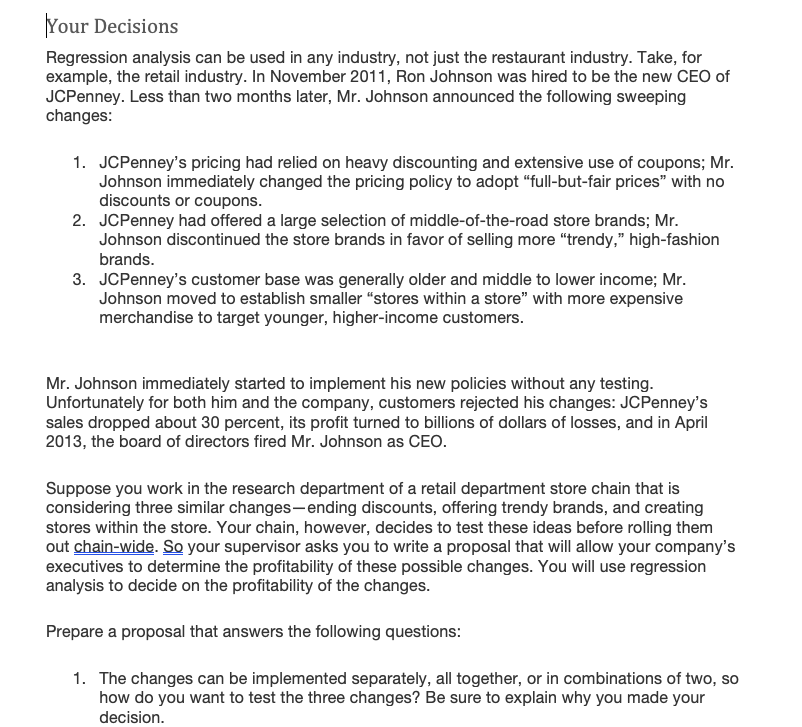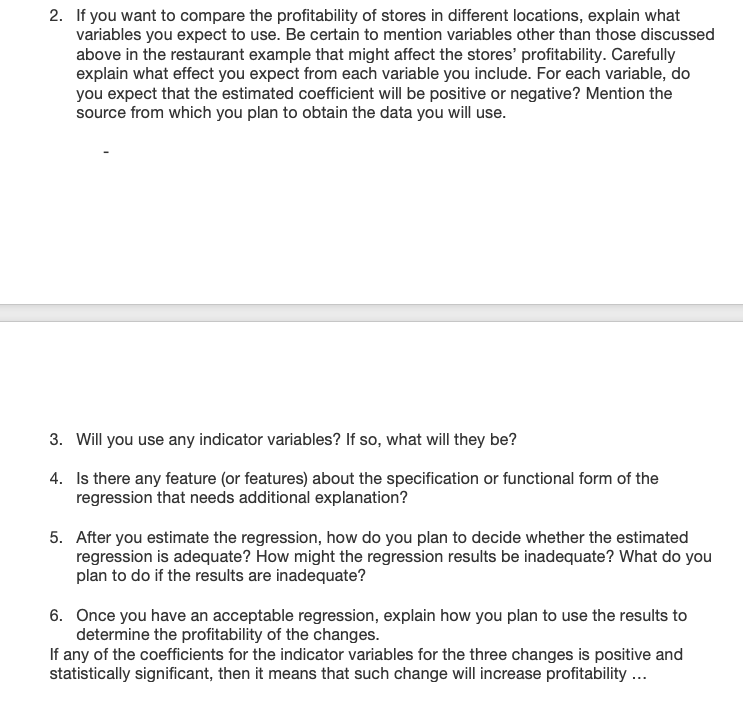

Your Decisions Regression analysis can be used in any industry, not just the restaurant industry. Take, for example, the retail industry. In November 2011, Ron Johnson was hired to be the new CEO of JCPenney. Less than two months later, Mr. Johnson announced the following sweeping changes: 1. JCPenney's pricing had relied on heavy discounting and extensive use of coupons, Mr. Johnson immediately changed the pricing policy to adopt "full-but-fair prices" with no discounts or coupons. 2. JCPenney had offered a large selection of middle-of-the-road store brands; Mr. Johnson discontinued the store brands in favor of selling more "trendy," high-fashion brands. 3. JCPenney's customer base was generally older and middle to lower income; Mr. Johnson moved to establish smaller "stores within a store" with more expensive merchandise to target younger, higher-income customers. Mr. Johnson immediately started to implement his new policies without any testing. Unfortunately for both him and the company, customers rejected his changes: JCPenney's sales dropped about 30 percent, its profit turned to billions of dollars of losses, and in April 2013, the board of directors fired Mr. Johnson as CEO. Suppose you work in the research department of a retail department store chain that is considering three similar changes-ending discounts, offering trendy brands, and creating stores within the store. Your chain, however, decides to test these ideas before rolling them out chain-wide. So your supervisor asks you to write a proposal that will allow your company's executives to determine the profitability of these possible changes. You will use regression analysis to decide on the profitability of the changes. Prepare a proposal that answers the following questions: 1. The changes can be implemented separately, all together, or in combinations of two, so how do you want to test the three changes? Be sure to explain why you made your decision. 2. If you want to compare the profitability of stores in different locations, explain what variables you expect to use. Be certain to mention variables other than those discussed above in the restaurant example that might affect the stores' profitability. Carefully explain what effect you expect from each variable you include. For each variable, do you expect that the estimated coefficient will be positive or negative? Mention the source from which you plan to obtain the data you will use. 3. Will you use any indicator variables? If so, what will they be? 4. Is there any feature (or features) about the specification or functional form of the regression that needs additional explanation? 5. After you estimate the regression, how do you plan to decide whether the estimated regression is adequate? How might the regression results be inadequate? What do you plan to do if the results are inadequate? 6. Once you have an acceptable regression, explain how you plan to use the results to determine the profitability of the changes. If any of the coefficients for the indicator variables for the three changes is positive and statistically significant, then it means that such change will increase profitability ... Your Decisions Regression analysis can be used in any industry, not just the restaurant industry. Take, for example, the retail industry. In November 2011, Ron Johnson was hired to be the new CEO of JCPenney. Less than two months later, Mr. Johnson announced the following sweeping changes: 1. JCPenney's pricing had relied on heavy discounting and extensive use of coupons, Mr. Johnson immediately changed the pricing policy to adopt "full-but-fair prices" with no discounts or coupons. 2. JCPenney had offered a large selection of middle-of-the-road store brands; Mr. Johnson discontinued the store brands in favor of selling more "trendy," high-fashion brands. 3. JCPenney's customer base was generally older and middle to lower income; Mr. Johnson moved to establish smaller "stores within a store" with more expensive merchandise to target younger, higher-income customers. Mr. Johnson immediately started to implement his new policies without any testing. Unfortunately for both him and the company, customers rejected his changes: JCPenney's sales dropped about 30 percent, its profit turned to billions of dollars of losses, and in April 2013, the board of directors fired Mr. Johnson as CEO. Suppose you work in the research department of a retail department store chain that is considering three similar changes-ending discounts, offering trendy brands, and creating stores within the store. Your chain, however, decides to test these ideas before rolling them out chain-wide. So your supervisor asks you to write a proposal that will allow your company's executives to determine the profitability of these possible changes. You will use regression analysis to decide on the profitability of the changes. Prepare a proposal that answers the following questions: 1. The changes can be implemented separately, all together, or in combinations of two, so how do you want to test the three changes? Be sure to explain why you made your decision. 2. If you want to compare the profitability of stores in different locations, explain what variables you expect to use. Be certain to mention variables other than those discussed above in the restaurant example that might affect the stores' profitability. Carefully explain what effect you expect from each variable you include. For each variable, do you expect that the estimated coefficient will be positive or negative? Mention the source from which you plan to obtain the data you will use. 3. Will you use any indicator variables? If so, what will they be? 4. Is there any feature (or features) about the specification or functional form of the regression that needs additional explanation? 5. After you estimate the regression, how do you plan to decide whether the estimated regression is adequate? How might the regression results be inadequate? What do you plan to do if the results are inadequate? 6. Once you have an acceptable regression, explain how you plan to use the results to determine the profitability of the changes. If any of the coefficients for the indicator variables for the three changes is positive and statistically significant, then it means that such change will increase profitability








